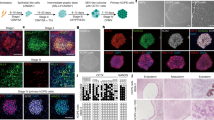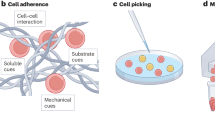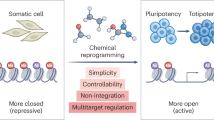Abstract
The Nobel Prize in Physiology and Medicine 2012 was awarded to Sir John B GURDON and Shinya YAMANAKA for their discovery that mature cells can be reprogrammed to become pluripotent. This event reaffirms the importance of research on cell fate plasticity and the technology progress in the stem cell field and regenerative medicine. Indeed, reprogramming technology has developed at a dazzling speed within the past 6 years, yet we are still at the early stages of understanding the mechanisms of cell fate identity. This is particularly true in the case of human induced pluripotent stem cells (iPSCs), which lack reliable standards in the evaluation of their fidelity and safety prior to their application. Along with the genetic approaches, small molecules nowadays become convenient tools for modulating endogenous protein functions and regulating key cellular processes, including the mesenchymal-to-epithelial transition, metabolism, signal transduction and epigenetics. Moreover, small molecules may affect not only the efficiency of clone formation but also the quality of the resulting cells. With increasing availability of such chemicals, we can better understand the biology of stems cells and further improve the technology of generation of stem cells.
Similar content being viewed by others
Log in or create a free account to read this content
Gain free access to this article, as well as selected content from this journal and more on nature.com
or
References
Waddington CH . The strategy of the genes. London: George Allen and Unwin; 1957.
Jaenisch R . Nuclear cloning and direct reprogramming: the long and the short path to Stockholm. Cell Stem Cell 2012; 11: 744–7.
Yamanaka S . Induced pluripotent stem cells: past, present, and future. Cell Stem Cell 2012; 10: 678–84.
Banito A, Gil J . Induced pluripotent stem cells and senescence: learning the biology to improve the technology. EMBO Rep 2010; 11: 353–9.
Esteban MA, Bao X, Zhuang Q, Zhou T, Qin B, Pei D . The mesenchymal-to-epithelial transition in somatic cell reprogramming. Curr Opin Genet Dev 2012; 22: 423–8.
Zhang J, Nuebel E, Daley GQ, Koehler CM, Teitell MA . Metabolic regulation in pluripotent stem cells during reprogramming and self-renewal. Cell Stem Cell 2012; 11: 589–95.
Pasque V, Jullien J, Miyamoto K, Halley-Stott RP, Gurdon JB . Epigenetic factors influencing resistance to nuclear reprogramming. Trends Genet 2011; 27: 516–25.
Nie B, Wang H, Laurent T, Ding S . Cellular reprogramming: a small molecule perspective. Curr Opin Cell Biol 2012; 24: 784–92.
Li W, Jiang K, Ding S . Concise review: A chemical approach to control cell fate and function. Stem Cells 2012; 30: 61–8.
Ichida JK, Blanchard J, Lam K, Son EY, Chung JE, Egli D, et al. A small-molecule inhibitor of TGF-beta signaling replaces sox2 in reprogramming by inducing nanog. Cell Stem Cell 2009; 5: 491–503.
Lin T, Ambasudhan R, Yuan X, Li W, Hilcove S, Abujarour R, et al. A chemical platform for improved induction of human iPSCs. Nat Methods 2009; 6: 805–8.
Maherali N, Hochedlinger K . TGFbeta signal inhibition cooperates in the induction of iPSCs and replaces Sox2 and cMyc. Curr Biol 2009; 19: 1718–23.
Samavarchi–Tehrani P, Golipour A, David L, Sung HK, Beyer TA, Datti A, et al. Functional genomics reveals a BMP-driven mesenchymal-to-epithelial transition in the initiation of somatic cell reprogramming. Cell Stem Cell 2010; 7: 64–77.
Li R, Liang J, Ni S, Zhou T, Qing X, Li H, et al. A mesenchymal-to-epithelial transition initiates and is required for the nuclear reprogramming of mouse fibroblasts. Cell Stem Cell 2010; 7: 51–63.
Chen T, Yuan D, Wei B, Jiang J, Kang J, Ling K, et al. E-cadherin-mediated cell-cell contact is critical for induced pluripotent stem cell generation. Stem Cells 2010; 28: 1315–25.
Kondoh H, Lleonart ME, Nakashima Y, Yokode M, Tanaka M, Bernard D, et al. A high glycolytic flux supports the proliferative potential of murine embryonic stem cells. Antioxid Redox Signal 2007; 9: 293–9.
Yoshida Y, Takahashi K, Okita K, Ichisaka T, Yamanaka S . Hypoxia enhances the generation of induced pluripotent stem cells. Cell Stem Cell 2009; 5: 237–41.
Majmundar AJ, Wong WJ, Simon MC . Hypoxia-inducible factors and the response to hypoxic stress. Mol Cell 2010; 40: 294–309.
Zeuschner D, Mildner K, Zaehres H, Scholer HR . Induced pluripotent stem cells at nanoscale. Stem Cells Dev 2010; 19: 615–20.
Prigione A, Fauler B, Lurz R, Lehrach H, Adjaye J . The senescence-related mitochondrial/oxidative stress pathway is repressed in human induced pluripotent stem cells. Stem Cells 2010; 28: 721–33.
Zhu S, Li W, Zhou H, Wei W, Ambasudhan R, Lin T, et al. Reprogramming of human primary somatic cells by OCT4 and chemical compounds. Cell Stem Cell 2010; 7: 651–5.
Folmes CD, Nelson TJ, Martinez-Fernandez A, Arrell DK, Lindor JZ, Dzeja PP, et al. Somatic oxidative bioenergetics transitions into pluripotency-dependent glycolysis to facilitate nuclear reprogramming. Cell Metab 2011; 14: 264–71.
Folmes CD, Dzeja PP, Nelson TJ, Terzic A . Metabolic plasticity in stem cell homeostasis and differentiation. Cell Stem Cell 2012; 11: 596–606.
Ying QL, Wray J, Nichols J, Batlle-Morera L, Doble B, Woodgett J, et al. The ground state of embryonic stem cell self-renewal. Nature 2008; 453: 519–23.
Silva J, Barrandon O, Nichols J, Kawaguchi J, Theunissen TW, Smith A . Promotion of reprogramming to ground state pluripotency by signal inhibition. PLoS Biol 2008; 6: e253.
Martello G, Sugimoto T, Diamanti E, Joshi A, Hannah R, Ohtsuka S, et al. Esrrb is a pivotal target of the Gsk3/Tcf3 axis regulating embryonic stem cell self-renewal. Cell Stem Cell 2012; 11: 491–504.
Feng B, Jiang J, Kraus P, Ng JH, Heng JC, Chan YS, et al. Reprogramming of fibroblasts into induced pluripotent stem cells with orphan nuclear receptor Esrrb. Nat Cell Biol 2009; 11: 197–203.
Festuccia N, Osorno R, Halbritter F, Karwacki-Neisius V, Navarro P, Colby D, et al. Esrrb is a direct Nanog target gene that can substitute for Nanog function in pluripotent cells. Cell Stem Cell 2012; 11: 477–90.
Marks H, Kalkan T, Menafra R, Denissov S, Jones K, Hofemeister H, et al. The transcriptional and epigenomic foundations of ground state pluripotency. Cell 2012; 149: 590–604.
Li Z, Rana TM . A kinase inhibitor screen identifies small-molecule enhancers of reprogramming and iPS cell generation. Nat Commun 2012; 3: 1085–95.
Xu X, Wang Q, Long Y, Zhang R, Wei X, Xing M, et al. Stress-mediated p38 activation promotes somatic cell reprogramming. Cell Res 2013; 23: 131–41.
Lee DF, Su J, Ang YS, Carvajal-Vergara X, Mulero-Navarro S, Pereira CF, et al. Regulation of embryonic and induced pluripotency by aurora kinase-p53 signaling. Cell Stem Cell 2012; 11: 179–94.
Gurdon JB, Elsdale TR, Fischberg M . Sexually mature individuals of Xenopus laevis from the transplantation of single somatic nuclei. Nature 1958; 182: 64–5.
Jones PA . Functions of DNA methylation: islands, start sites, gene bodies and beyond. Nat Rev Genet 2012; 13: 484–92.
Bannister AJ, Kouzarides T . Regulation of chromatin by histone modifications. Cell Res 2011; 21: 381–95.
Han JW, Yoon YS . Epigenetic landscape of pluripotent stem cells. Antioxid Redox Signal 2012; 17: 205–23.
Mikkelsen TS, Hanna J, Zhang X, Ku M, Wernig M, Schorderet P, et al. Dissecting direct reprogramming through integrative genomic analysis. Nature 2008; 454: 49–55.
Huangfu D, Maehr R, Guo W, Eijkelenboom A, Snitow M, Chen AE, et al. Induction of pluripotent stem cells by defined factors is greatly improved by small-molecule compounds. Nat Biotechnol 2008; 26: 795–7.
Polo JM, Anderssen E, Walsh RM, Schwarz BA, Nefzger CM, Lim SM, et al. A molecular roadmap of reprogramming somatic cells into iPS cells. Cell 2012; 151: 1617–32.
Branco MR, Ficz G, Reik W . Uncovering the role of 5-hydroxymethylcytosine in the epigenome. Nat Rev Genet 2012; 13: 7–13.
Costa Y, Ding J, Theunissen TW, Faiola F, Hore TA, Shliaha PV, et al. Nanog-dependent function of TET1 and TET2 in establishment of pluripotency. Nature 2013; 495: 370–4.
Piccolo FM, Bagci H, Brown KE, Landeira D, Soza-Ried J, Feytout A, et al. Different roles for Tet1 and Tet2 proteins in reprogramming-mediated erasure of imprints induced by EGC fusion. Mol Cell 2013; 49: 1023–33.
Gao Y, Chen J, Li K, Wu T, Huang B, Liu W, et al. Replacement of Oct4 by Tet1 during iPSC induction reveals an important role of DNA methylation and hydroxymethylation in reprogramming. Cell Stem Cell 2013; 12: 453–69.
Kimura H, Tada M, Nakatsuji N, Tada T . Histone code modifications on pluripotential nuclei of reprogrammed somatic cells. Mol Cell Biol 2004; 24: 5710–20.
Mali P, Chou BK, Yen J, Ye Z, Zou J, Dowey S, et al. Butyrate greatly enhances derivation of human induced pluripotent stem cells by promoting epigenetic remodeling and the expression of pluripotency-associated genes. Stem Cells 2010; 28: 713–20.
Liang G, Taranova O, Xia K, Zhang Y . Butyrate promotes induced pluripotent stem cell generation. J Biol Chem 2010; 285: 25516–21.
Huangfu D, Osafune K, Maehr R, Guo W, Eijkelenboom A, Chen S, et al. Induction of pluripotent stem cells from primary human fibroblasts with only Oct4 and Sox2. Nat Biotechnol 2008; 26: 1269–75.
Zhou H, Wu S, Joo JY, Zhu S, Han DW, Lin T, et al. Generation of induced pluripotent stem cells using recombinant proteins. Cell Stem Cell 2009; 4: 381–4.
Anokye-Danso F, Trivedi CM, Juhr D, Gupta M, Cui Z, Tian Y, et al. Highly efficient miRNA-mediated reprogramming of mouse and human somatic cells to pluripotency. Cell Stem Cell 2011; 8: 376–88.
Stadtfeld M, Apostolou E, Akutsu H, Fukuda A, Follett P, Natesan S, et al. Aberrant silencing of imprinted genes on chromosome 12qF1 in mouse induced pluripotent stem cells. Nature 2010; 465: 175–81.
Donohoe DR, Collins LB, Wali A, Bigler R, Sun W, Bultman SJ . The warburg effect dictates the mechanism of butyrate–mediated histone acetylation and cell proliferation. Mol Cell 2012; 48: 612–26.
Pandian GN, Nakano Y, Sato S, Morinaga H, Bando T, Nagase H, et al. A synthetic small molecule for rapid induction of multiple pluripotency genes in mouse embryonic fibroblasts. Sci Rep 2012; 2: 544–51.
Greer EL, Shi Y . Histone methylation: a dynamic mark in health, disease and inheritance. Nat Rev Genet 2012; 13: 343–57.
Shi Y, Desponts C, Do JT, Hahm HS, Scholer HR, Ding S . Induction of pluripotent stem cells from mouse embryonic fibroblasts by Oct4 and Klf4 with small-molecule compounds. Cell Stem Cell 2008; 3: 568–74.
Shi Y, Do JT, Desponts C, Hahm HS, Scholer HR, Ding S . A combined chemical and genetic approach for the generation of induced pluripotent stem cells. Cell Stem Cell 2008; 2: 525–8.
Onder TT, Kara N, Cherry A, Sinha AU, Zhu N, Bernt KM, et al. Chromatin-modifying enzymes as modulators of reprogramming. Nature 2012; 483: 598–602.
Li W, Zhou H, Abujarour R, Zhu S, Young Joo J, Lin T, et al. Generation of human-induced pluripotent stem cells in the absence of exogenous Sox2. Stem Cells 2009; 27: 2992–3000.
Wang Q, Xu X, Li J, Liu J, Gu H, Zhang R, et al. Lithium, an anti-psychotic drug, greatly enhances the generation of induced pluripotent stem cells. Cell Res 2011; 21: 1424–35.
Esteban MA, Wang T, Qin B, Yang J, Qin D, Cai J, et al. Vitamin C enhances the generation of mouse and human induced pluripotent stem cells. Cell Stem Cell 2010; 6: 71–9.
Horton JR, Upadhyay AK, Qi HH, Zhang X, Shi Y, Cheng X . Enzymatic and structural insights for substrate specificity of a family of jumonji histone lysine demethylases. Nat Struct Mol Biol 2010; 17: 38–43.
Loenarz C, Schofield CJ . Expanding chemical biology of 2-oxoglutarate oxygenases. Nat Chem Biol 2008; 4: 152–6.
Wang T, Chen K, Zeng X, Yang J, Wu Y, Shi X, et al. The histone demethylases Jhdm1a/1b enhance somatic cell reprogramming in a vitamin-C-dependent manner. Cell Stem Cell 2011; 9: 575–87.
Chen J, Liu H, Liu J, Qi J, Wei B, Yang J, et al. H3K9 methylation is a barrier during somatic cell reprogramming into iPSCs. Nat Genet 2012; 45: 34–42.
Chen J, Liu J, Yang J, Chen Y, Chen J, Ni S, et al. BMPs functionally replace Klf4 and support efficient reprogramming of mouse fibroblasts by Oct4 alone. Cell Res 2011; 21: 205–12.
Stadtfeld M, Apostolou E, Ferrari F, Choi J, Walsh RM, Chen T, et al. Ascorbic acid prevents loss of Dlk1-Dio3 imprinting and facilitates generation of all-iPS cell mice from terminally differentiated B cells. Nat Genet 2012; 44: 398–405, S1–2.
Liu L . Activation of the imprinted Dlk1-Dio3 region correlates with pluripotency levels of mouse stem cells. J Biol Chem 2010; 285: 19483–90.
Esteban MA, Pei D . Vitamin C improves the quality of somatic cell reprogramming. Nat Genet 2012; 44: 366–7.
Tohyama S, Hattori F, Sano M, Hishiki T, Nagahata Y, Matsuura T, et al. Distinct metabolic flow enables large-scale purification of mouse and human pluripotent stem cell-derived cardiomyocytes. Cell Stem Cell 2013; 12: 127–37.
Wang L, Wang L, Huang W, Su H, Xue Y, Su Z, et al. Generation of integration–free neural progenitor cells from cells in human urine. Nat Methods 2012; 10: 84–9.
Huang J, Nguyen-McCarty M, Hexner EO, Danet-Desnoyers G, Klein PS . Maintenance of hematopoietic stem cells through regulation of Wnt and mTOR pathways. Nat Med 2012; 18: 1778–85.
Acknowledgements
We thank Miguel Angel ESTEBAN, Qiang ZHUANG, and Xi-chen BAO for their helpful suggestions. The studies in the authors' laboratories were supported by the Strategic Priority Research Program of the Chinese Academy of Sciences (grant XDA01020401) and the National Basic Research Program of China (grants 2011CBA01106 and 2011CBA01004).
Author information
Authors and Affiliations
Corresponding author
PowerPoint slides
Rights and permissions
About this article
Cite this article
Su, Jb., Pei, Dq. & Qin, Bm. Roles of small molecules in somatic cell reprogramming. Acta Pharmacol Sin 34, 719–724 (2013). https://doi.org/10.1038/aps.2013.73
Received:
Accepted:
Published:
Issue date:
DOI: https://doi.org/10.1038/aps.2013.73
Keywords
This article is cited by
-
ETV2/ER71, the key factor leading the paths to vascular regeneration and angiogenic reprogramming
Stem Cell Research & Therapy (2023)
-
JMJD3 acts in tandem with KLF4 to facilitate reprogramming to pluripotency
Nature Communications (2020)
-
Genome-wide DNA methylation analysis reveals that mouse chemical iPSCs have closer epigenetic features to mESCs than OSKM-integrated iPSCs
Cell Death & Disease (2018)
-
Cellular reprogramming for clinical cartilage repair
Cell Biology and Toxicology (2017)
-
Chemical-only reprogramming to pluripotency
Frontiers in Biology (2016)



